
The Alexander Valley is a Californian American Viticultural Area (AVA) just north of Healdsburg in Sonoma County. It is home to many wineries and vineyards, as well as the city of Cloverdale. It is the largest and most fully planted wine region in Sonoma. Highway 101 runs through the valley, and the Russian River flows down the valley, surrounded by vineyards on both sides. From the higher elevations of the valley rim, there is a view as far south as Taylor Mountain and Sonoma Mountain. The region was named for Cyrus Alexander, owner of a part of the Rancho Sotoyome Mexican land grant, in 1847. Granted AVA status in 1984, the boundaries of the appellation are defined in the Code of Federal Regulations, Title 27, Section 9.53.

Napa Valley is an American Viticultural Area (AVA) located in Napa County, California. It was established by the Bureau of Alcohol, Tobacco and Firearms (ATF) on January 27, 1981. Napa Valley is considered one of the premier wine regions in the world. Records of commercial wine production in the region date back to the nineteenth century, but premium wine production dates back only to the 1960s.
Knights Valley AVA is an American Viticultural Area (AVA) in Sonoma County, California. One of Sonoma County's original five AVAs, Knights Valley AVA was formally designated an American Viticultural Area on October 21, 1983. Knights Valley AVA includes approximately 37,000 acres (150 km2). Over 30 growers maintain the 2,000 acres (8 km2) planted to wine grape vineyards. The easternmost designated Sonoma County wine region, Knights Valley AVA has the warmest climate in the county. The valley lies between the Alexander Valley AVA and Chalk Hill AVA wine regions to the west and the Mayacamas Mountains to the east. Geographically, the appellation separates the rest of Sonoma County from the Napa Valley AVA.

The Augusta AVA was established on June 20, 1980 as the first federally approved American Viticultural Area, eight months before the Napa Valley AVA in northern California. The petition was submitted by Clayton W. Byers and Lucian W. Dressel, representing the local wine industry, to the Director of the Bureau of Alcohol, Tobacco and Firearms on October 16, 1978. Located entirely within the state of Missouri, the boundaries of this wine region encompass 15 square miles (39 km2) around the city of Augusta near the intersection of St. Charles County, Warren County and Franklin County.
Guenoc Valley is an American Viticultural Area in Lake County, California, United States, about 15 mi (24 km) north of the town of Calistoga. Guenoc Valley AVA was the first American Viticultural Area designation granted to an area with just a single winery.
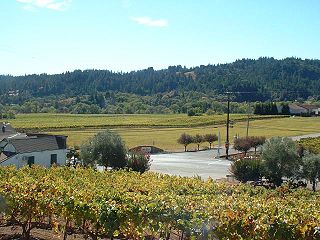
Sonoma County wine is wine made in Sonoma County, California, in the United States.
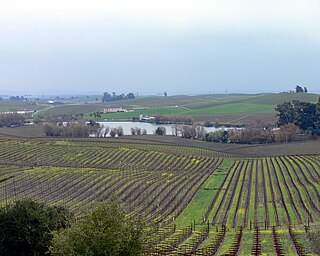
Los Carneros AVA is an American Viticultural Area which includes parts of both Sonoma and Napa counties in California, U.S.A. It is located north of San Pablo Bay. The proximity to the cool fog and breezes from the bay makes the climate in Los Carneros cooler and more moderate than the wine regions farther north in Napa Valley and Sonoma Valley. The cooler climate has made Los Carneros attractive for the cultivation of cooler climate varietals like Pinot noir and Chardonnay. Many of the grapes grown in Los Carneros are used for sparkling wine production. Receiving its AVA status in 1983, the Carneros area was the first wine region in California to be defined by its climate characteristics rather than political boundaries.
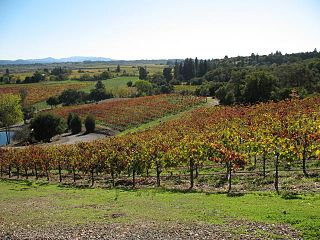
The North Coast AVA is an American Viticultural Area in the state of California that encompasses grape-growing regions in six counties located north of San Francisco: Lake, Marin, Mendocino, Napa, Sonoma, and Solano. This large appellation covers over 3,000,000 acres (5,000 sq mi) and includes a number of smaller sub-appellations that all share the common ecology trait of weather affected by the fog and breezes off the Pacific Ocean.
The Northern Sonoma AVA is an American Viticultural Area in Sonoma County, California, United States. The appellation covers most of the county with the notable exceptions of the Los Carneros AVA and Sonoma Valley AVA wine regions, which are located in the southern portion of the county. The creation of this AVA was largely based on the petitioning of the E & J Gallo Winery as part of their expansion of their Gallo of Sonoma brand. The viticultural area incorporates the Alexander Valley AVA, Chalk Hill AVA, Dry Creek Valley AVA, Knights Valley AVA, Russian River Valley AVA, Sonoma Coast AVA, and parts of the Green Valley of Russian River Valley AVA and Rockpile AVA valleys.

The Oakville AVA is an American Viticultural Area located within Napa Valley AVA and centered on the town of Oakville, California. The appellation extends over a flat expanse of well-drained gravel soil between the Vaca and Mayacamas Mountains. Oakville AVA is known for its success with Bordeaux varietals, which have produced wines of rich texture, firm tannins, and notes of mint and herbs.

St. Helena is an American Viticultural Area (AVA) located within Napa Valley, centered in and around the town of St. Helena, California. It was established by the Bureau of Alcohol, Tobacco and Firearms (ATF) on October 11, 1995, after the ATF received a petition from Mr. Charles A. Carpy, Chairman of the St. Helena Appellation Committee, proposing to establish a new viticultural area in Napa County to be known as "St. Helena."
The Chiles Valley is an American Viticultural Area (AVA) located in Napa County, California and a sub-region within Napa Valley AVA. It was established as California's 81st AVA by the Bureau of Alcohol, Tobacco and Firearms (ATF) on April 19, 1999 after the ATF received the petition from Mr. Volker Eisele, owner of the Volker Eisele Vineyard and Winery proposing a new viticultural area in Napa County to be known as "Chiles Valley District".

The Diamond Mountain District AVA is an American Viticultural Area located in California's Mayacamas Mountains in the northwest portion of the Napa Valley AVA. The appellation sits at a higher elevation than most of Napa Valley's wine region, resulting in less cool fog coming in from San Pablo Bay, and more direct exposure to sunlight. The soil of this AVA is volcanic and very porous which allows it to cool down quickly despite the increased sunlight.

The Howell Mountain AVA is an American Viticultural Area located within Napa Valley AVA of California.
The Wild Horse Valley AVA is an American Viticultural Area whose borders overlap both Napa County and Solano County, California and is partially contained within the Napa Valley AVA. The appellation's southerly location results in more hours of sunshine than other locations in Napa Valley or nearby Green Valley. The proximity to San Pablo Bay results in a cooler climate, making Wild Horse Valley attractive for the cultivation of grapes like Pinot noir.

The Spring Mountain District AVA is an American Viticultural Area located in the Napa Valley AVA in California. Spring Mountain District AVA was officially established as an American Viticulture Area in 1993. Encompassed within its bounds are about 8,600 acres (3,480 ha), of which about 1,000 acres (400 ha) are planted to vineyards. Given the small crop yields on hillsides, the region represents less than 2% of Napa Valley wine. Currently the region has just over 30 winegrowers.
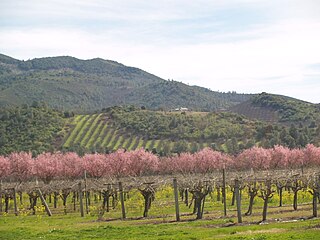
Lake County wine is an appellation that designates wine made from grapes grown mostly in Lake County, California. The region is located north of Napa County and east of Mendocino County. Although each region within Lake County has unique viticultural attributes, many are influenced by Clear Lake, the largest inland body of water in California.
The Solano County Green Valley AVA is an American Viticultural Area located in Solano County, California. Located southeast of the Napa Valley AVA, Green Valley is about 1 mile (1.6 km) wide and 4 miles (6.4 km) long. The valley is close to San Pablo Bay and thus has a maritime climate. Most of the vineyards are planted on the valley floor and benefit from moist, cooling winds in the summer afternoons.
The Pine Mountain-Cloverdale Peak AVA is an American Viticultural Area in Sonoma County. It is located at the top of Pine Mountain, at the Northern end of the Mayacamas Range, which separates the Napa and Sonoma growing regions. The AVA, which rises between 1600 feet at its lowest point to 2600 feet at its highest, is one of the highest grape growing regions in California.
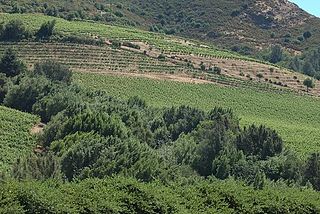
Moon Mountain District Sonoma County is an American Viticultural Area (AVA) within Sonoma Valley and North Coast viticultural areas, just north of the city of Sonoma. This mountainous region on the very eastern edge of Sonoma County has a historic reputation for producing rich, intensely-flavored wines from Cabernet Sauvignon and Syrah varietals since the 1880s. The District was established on November 1, 2013, by the Alcohol and Tobacco Tax and Trade Bureau (TTB). Its designation covers 17,663 acres (28 sq mi) of land stretching north-south along the western slopes of the Mayacamas mountains between Sugarloaf Ridge State Park and Los Carneros viticultural area with the Napa Valley’s Mount Veeder viticultural area outlining the eastern slopes. Its name is derived from Moon Mountain Road, which traverses through the area and itself a reference to Sonoma, which means 'valley of the moon' in the local Native American dialect. A clear view to San Francisco 50 miles (80 km) south is not uncommon from Moon Mountain District vineyards.













